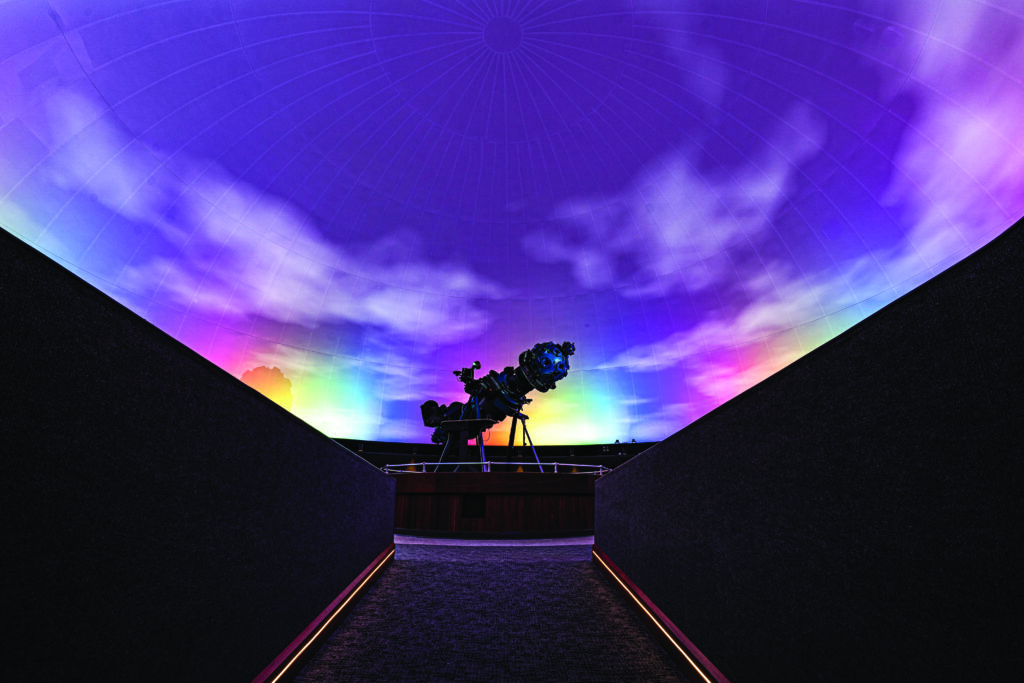
How often do you find yourself stargazing? If you live in or near a city, chances are it might not be frequent. Urban areas have more difficulty observing dark sky features because of light pollution. Artificial night-time light, from things like cars and streetlamps, reduces visibility of stars, affecting how city-dwellers see the sky.
Somewhere you can see the stars spectacularly, even in the heart of Rochester, is Strasenburgh Planetarium. There, you’ll find reclining chairs and a massive projection above your head that can show up-close footage of the farthest planet in our solar system and views of our galaxy from the outside.
The weekly show The Sky Tonight is a tour through the constellations and planets in position at local time and location. As the sky darkens, a live presenter will guide you around overhead, identifying our north star, Polaris, and various constellations visible in the season. Monthly, Stars with Carl is hosted, using the original star projector (named Carl) that the planetarium opened with in 1968. This projector has less capabilities than the full dome projector but is a lovely show to highlight our galactic neighbors.
The Sun: Our Living Star is a new show that presents recent unique footage of the sun’s surface. Produced by the European Southern Observatory, the Chile-based researchers captured stunning visuals with spacecraft satellites that will give you an intense view of the volatile star that is the Sun. The Northern Lights are solar weather that the program teaches a bit about, something that was seen by Western New Yorkers this May.
Like 2024’s total solar eclipse, celestial events that generate excitement are opportunities for people not extensively interested in astronomy to tune into the happenings of space. Planetarium director Jim Bader says the best part of his job is when people become aware and ask questions; sharing “the beauty of the universe” never gets old.

Don’t let the complexity of astronomy scare you away, these shows are recommended for ages fi ve and up, making this the perfect balance of scientific discovery and visual wonder. Bader recalls his fi rst planetarium experience: “I don’t remember the science that I learned, but I remember seeing absolutely incredible things and feeling that I was transported, and that feeling of excitement and interest and immersiveness is a big factor to why I pursued a science degree.”
The mesmerizing beauty of these shows will pull you in and hopefully have you hooked to dive into the explanations. The new interactive exhibition, Same Sky aims to do just that, highlighting the Indigenous North American tradition of sky watching and their origin stories influenced by stars. In the video portion, planetarium visitors can choose the topics they’d enjoy learning about like the Mayan calendar and counting system.
The constellations we know by name are largely of a Western European viewpoint, and but societies all over the world used the stars to navigate and tell stories. The Maya were leaders in celestial observing, they recorded sophisticated predictions that repeated themselves, and were some of the first to use the concept of “zero.”

Haudenosaunee, Diné, and Mayan Knowledge Keepers curated the display to represent their respective cultural understandings of the sky and celestial activities. Rochester Museum and Science Center (RMSC) felt the need to broaden the scope in which we think of astronomy, and this exhibit is the product of looking at the sky from a different angle. Bader says he likes to point out Maui’s Fishhook in the summer and talk about the different global perspectives of the Big Dipper.
In addition to the Haudenosaunee’s featured artwork, local contributions to space research are greatly appreciated in another exhibit. Rochester has been integral to the optic (relating to the eye) industry for decades, Kodak and telescope construction specifically. Gambit Satellite Optic System is a declassified spy satellite that is on display at the planetarium for you to stand beside. The opportunity to be at such a close distance to an object that orbited Earth for four years is not one you get often. Gambit captured the first high-resolution satellite photography in the 1960s, an impressive technological feat, produced right here at home.
Other demonstrations hosted at the planetarium are music laser light shows. Just opened is a Beyoncé laser show featuring fourteen songs over fifty-five minutes where you will be dazzled by the vibrant performance. Pink Floyd’s Dark Side of the Moon is another laser show new to the schedule. This “mind-bending light and sound landscape” brings an exciting twist to one of the most iconic rock albums.
Coming to Strasenburgh Planetarium this July is a space exploration program as well as a laser show featuring the music by The Weeknd.
If any of these presentations caught your attention, be sure to pay RMSC’s Strasenburgh Planetarium a visit this summer to experience an unforgettable day of curiosity and amazement.
Views: 1




